INSTITUT SUPERIEUR D'ANTHROPOLOGIE
INSTITUTE OF ANTHROPOLOGY
ONLINE COURSES / COURS A DISTANCE
FALL TERM : OCTOBER 2015
REGISTER NOW
MONGOLIE – 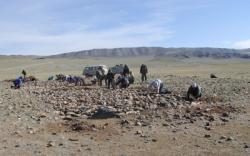 Bayan-Ölgii - Scholars from the Altai State University (Russia) have found an ancient burial site while conducting excavations in the mountain valley of the Mongolian rural municipality of Bayan-Ölgii. Archaeologists said that the discovery is unique for the region, according to the Montsame National News Agency. Works in Mongolia are held along with researchers from China and Mongolia. Scholars study the Early Bronze Age objects found during the Altai's expedition last year, including the burial site which is preliminarily aged the 3rd millennium BC. For over two months, the archaeologists have been cleaning the stone construction area of 1,200 square meters. The barrow has a difficult structure with fences and large plates. Temple of the burial site corresponds to the ancient canons as it is located in the east. There are a ritual altar and other buildings. One can see the images of warriors with spears, hunting scenes, animals on the plates. The archaeologists claim that no similar sites have been ever found in the mountains of Mongolian Altai.
Bayan-Ölgii - Scholars from the Altai State University (Russia) have found an ancient burial site while conducting excavations in the mountain valley of the Mongolian rural municipality of Bayan-Ölgii. Archaeologists said that the discovery is unique for the region, according to the Montsame National News Agency. Works in Mongolia are held along with researchers from China and Mongolia. Scholars study the Early Bronze Age objects found during the Altai's expedition last year, including the burial site which is preliminarily aged the 3rd millennium BC. For over two months, the archaeologists have been cleaning the stone construction area of 1,200 square meters. The barrow has a difficult structure with fences and large plates. Temple of the burial site corresponds to the ancient canons as it is located in the east. There are a ritual altar and other buildings. One can see the images of warriors with spears, hunting scenes, animals on the plates. The archaeologists claim that no similar sites have been ever found in the mountains of Mongolian Altai.
http://www.akipress.com/news:562992/?
IRAN – 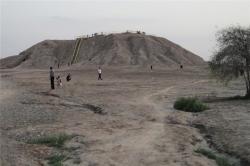 Mahtaj Hill - Head of the speculation and exploration team in Mahtaj Hill in Behbahan,Khuzestan Province, says signs of a 9000-year-old settlement have been discovered in the site. Hojjat Darabi said on Monday the results obtained from speculation and exploration operations carried out in Mahtaj Hill of Behbahan in Khuzestan Province which includes the earliest evidence on farming and animal husbandry in this region indicates the existence of a nine-thousand-year-old Pre-Pottery settlement in Behbahan. Mahtaj Hill, located to the northwest of Behbahan, was registered as a Pre-Pottery Neolithic site last year following the archaeological research conducted by Abbas Moghadam. All the site’s surface has been flattened and very little remains of the lower layers of the settlement, said Darabi. “The findings mostly include stone tools such as grindstone and its handle which shows that producing and processing of vegetarian food played an important role in the livelihood of Mahtaj Hill inhabitants," said the Iranian archaeologist. According to Darabi, Mahtaj Hill can provide the earliest evidence regarding farming and animal husbandry on the plains near the shores of the Persian Gulf.
Mahtaj Hill - Head of the speculation and exploration team in Mahtaj Hill in Behbahan,Khuzestan Province, says signs of a 9000-year-old settlement have been discovered in the site. Hojjat Darabi said on Monday the results obtained from speculation and exploration operations carried out in Mahtaj Hill of Behbahan in Khuzestan Province which includes the earliest evidence on farming and animal husbandry in this region indicates the existence of a nine-thousand-year-old Pre-Pottery settlement in Behbahan. Mahtaj Hill, located to the northwest of Behbahan, was registered as a Pre-Pottery Neolithic site last year following the archaeological research conducted by Abbas Moghadam. All the site’s surface has been flattened and very little remains of the lower layers of the settlement, said Darabi. “The findings mostly include stone tools such as grindstone and its handle which shows that producing and processing of vegetarian food played an important role in the livelihood of Mahtaj Hill inhabitants," said the Iranian archaeologist. According to Darabi, Mahtaj Hill can provide the earliest evidence regarding farming and animal husbandry on the plains near the shores of the Persian Gulf.
http://en.mehrnews.com/news/108979/Signs-of-9000-year-old-settlement-found-in-Behbahan
TURQUIE – 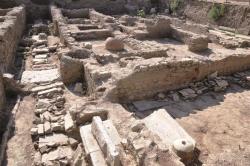 Iznik - A Byzantine-era chapel dating back to the 10th century has been unearthed by the Nilüfer Hatun Almshouse and Extension Construction and Environmental Project in the northwestern province of Bursa’s İznik district. The Council of Monuments, members of which have recently examined the area, will give the final decision about the construction of a new administration building and an archaeology museum called the İznik Green Museum.
Iznik - A Byzantine-era chapel dating back to the 10th century has been unearthed by the Nilüfer Hatun Almshouse and Extension Construction and Environmental Project in the northwestern province of Bursa’s İznik district. The Council of Monuments, members of which have recently examined the area, will give the final decision about the construction of a new administration building and an archaeology museum called the İznik Green Museum.
http://www.hurriyetdailynews.com/Default.aspx?pageID=238&nid=86365&NewsCatID=375
USA – 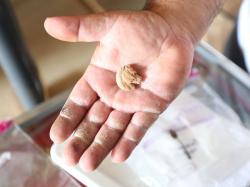 Philadelphie - When Michael Manerchia, a heavy-equipment operator, found pieces of a broken plate under the flooring of a home he was renovating in Marcus Hook, he had no idea that he had opened a treasure chest of history. Manerchia had purchased a rare "Plank House" - constructed with materials harvested from a ship dating from the early 18th Century. Manerchia sought help from professionals, and Temple University archaeology professors, students, and assorted volunteers came to the site and started digging. They uncovered 30,000 artifacts, including a snuff spoon, clay button, toy Hessian soldier, handmade domino, and pottery chards, and at least one 20th Century artifact - a roof handle to a Model T convertible. The site of Plank House was known as the house where the mistress of the notorious pirate Blackbeard lived. While Blackbeard likely visited the town, the stories about his mistress and the house have not been corroborated.
Philadelphie - When Michael Manerchia, a heavy-equipment operator, found pieces of a broken plate under the flooring of a home he was renovating in Marcus Hook, he had no idea that he had opened a treasure chest of history. Manerchia had purchased a rare "Plank House" - constructed with materials harvested from a ship dating from the early 18th Century. Manerchia sought help from professionals, and Temple University archaeology professors, students, and assorted volunteers came to the site and started digging. They uncovered 30,000 artifacts, including a snuff spoon, clay button, toy Hessian soldier, handmade domino, and pottery chards, and at least one 20th Century artifact - a roof handle to a Model T convertible. The site of Plank House was known as the house where the mistress of the notorious pirate Blackbeard lived. While Blackbeard likely visited the town, the stories about his mistress and the house have not been corroborated.
http://www.philly.com/philly/news/20150804_Home_renovation_turned_historical_preservation.html
ROYAUME UNI - Swindon - Roman fields and clay pits have been uncovered during surveys of land near Lydiard Park which is the subject of housing proposals. The discovery comes after initial geophysical surveys identified the potential for buried archaeological features. Fragments of Roman pottery have since been unearthed. Indications suggest the site had been used as agricultural fields, with a section possibly used for clay extraction. The clay would have been used for Roman pottery and tile kilns, many of which have been excavated nearby in recent years. Wessex Archaeology investigations at a site 300m away from the current project, found a significant Roman building. And it is believed these latest finds would have been an extension of that agricultural site.
http://www.swindonadvertiser.co.uk/news/13544506.Roman_artefacts_unearthed_at_site_earmarked_for_housing_development/
USA – Cabellsville - Cabellsville became the Amherst County seat when Albemarle County was divided in 1761, forming Amherst County. Court was held near Findley’s Gap from 1762 until the Cabellsville courthouse was completed in 1765. As Amherst County became too big, it was divided in 1809, thus forming Nelson, and court continued to be held at Cabellsville until the completion of a courthouse in Lovingston in 1810, Adams said. “That’s when Lovingston was formed as the county seat,” Adams said. “And the Amherst County seat was moved to Amherst town.” When it was no longer used for the judicial system, Cabellsville became a 90-acre farm village but burned down around 1917. The beginning of the dig started with a testing of the site and locating the areas where artifacts could be found. “We wanted to first find out if the site was intact or too disturbed,” Adams said. “We knew it had a historical background and there was a court, a jail, a 10-acre holding area for debtors, a bar with rooms to rent and a place to have food.” At the time that Cabellsville was thriving, from about 1765 to about 1810, the land included separate cells within the jail for criminals and 10 acres where those who owed money would roam freely and work to pay it off. Though the archaeologists do not know yet the internal layout of the jail, if it was like other jails in Virginia at that time, it would have had multiple cells and maybe even more than one story, Adams said. The archaeological team has located the courthouse and a portion of the foundation brick wall on which the wooden structure of the courthouse sat.
http://www.dailyprogress.com/news/local/cabellsville-mysteries-archaeologists-dig-up-nelson-community-from-s/article_61877a3e-396b-11e5-baef-b38db5b82733.html
TURQUIE – 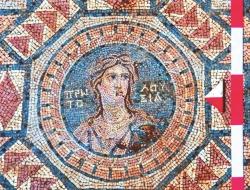 Olba - A mosaic that has been unearthed during excavations in the ancient city of Olba in the southern province of Mersin’s Silifke district has been removed in 16 different panels and placed under protection. According to a statement made by the General Directorate of Cultural Heritage and Museums, the mosaic was found by a Gazi University team headed by Professor Ayşe Emel Erten. The mosaic is now under protection in the garden of the Silifke Museum Directorate. Painstaking efforts have been expended on the mosaic, since the size of the tesseras (mosaic pieces) used in its production were smaller than one centimeter. The 35-centimeter mosaic is thin and breathtaking due to many colorful tesseras. One of the mosaics, which is made up of two different panels and diamond-shaped motifs that separate them from each other, has three portraits depicting two women and a man in the center. The portraits are known as Tryphe, Bios and Lucia in Greek and symbolize life and luxury. The other panel has five portraits, depicting a winged and cloaked angel. According to initial examinations, the mosaic dates back to the end of the second century A.D. and the first half of the third century. Restoration and conservation works on the mosaic are continuing, according to the statement.
Olba - A mosaic that has been unearthed during excavations in the ancient city of Olba in the southern province of Mersin’s Silifke district has been removed in 16 different panels and placed under protection. According to a statement made by the General Directorate of Cultural Heritage and Museums, the mosaic was found by a Gazi University team headed by Professor Ayşe Emel Erten. The mosaic is now under protection in the garden of the Silifke Museum Directorate. Painstaking efforts have been expended on the mosaic, since the size of the tesseras (mosaic pieces) used in its production were smaller than one centimeter. The 35-centimeter mosaic is thin and breathtaking due to many colorful tesseras. One of the mosaics, which is made up of two different panels and diamond-shaped motifs that separate them from each other, has three portraits depicting two women and a man in the center. The portraits are known as Tryphe, Bios and Lucia in Greek and symbolize life and luxury. The other panel has five portraits, depicting a winged and cloaked angel. According to initial examinations, the mosaic dates back to the end of the second century A.D. and the first half of the third century. Restoration and conservation works on the mosaic are continuing, according to the statement.
http://www.hurriyetdailynews.com/Default.aspx?pageID=238&nid=86422&NewsCatID=375
TURQUIE – 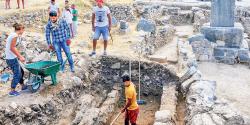 Xanthos - This year's summer excavations have commenced at the ancient Greek city of Xanthos, located in the Kaş district of the southwestern province of Antalya, according to the Doğan news agency. Work at the site has been led by Dr. Burhan Varkıvanç, an associate professor of archeology at Akdeniz University, since 2011 and he will continue to guide the project this year. “This year we will continue our work at three areas of the ancient city of Xanthos, which has a place among Turkey's 15 UNESCO World Heritage List valuable sites. The [excavation responsibility for the] location was transferred to Turkish archeologists in 2011 and we began excavating at the Western Agora, which will be continued this year,” Varkıvanç recently stated to the press. Dating back to the 4th century B.C., Xanthos was the first capital for the Lycians, and in 546 B.C. its inhabitants supposedly incinerated themselves on the acropolis rather than surrender to a Persian army led by Harpagos.
Xanthos - This year's summer excavations have commenced at the ancient Greek city of Xanthos, located in the Kaş district of the southwestern province of Antalya, according to the Doğan news agency. Work at the site has been led by Dr. Burhan Varkıvanç, an associate professor of archeology at Akdeniz University, since 2011 and he will continue to guide the project this year. “This year we will continue our work at three areas of the ancient city of Xanthos, which has a place among Turkey's 15 UNESCO World Heritage List valuable sites. The [excavation responsibility for the] location was transferred to Turkish archeologists in 2011 and we began excavating at the Western Agora, which will be continued this year,” Varkıvanç recently stated to the press. Dating back to the 4th century B.C., Xanthos was the first capital for the Lycians, and in 546 B.C. its inhabitants supposedly incinerated themselves on the acropolis rather than surrender to a Persian army led by Harpagos.
http://www.todayszaman.com/national_annual-summer-archeological-dig-begins-at-ancient-greek-city-of-xanthos-in-kas_395535.html?
ROYAUME UNI – 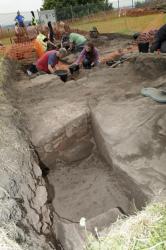 Halton Castle - Human skeletons have been found buried in the walls of Halton Castle. The two skeletons, believed to be a man and a woman, are thought to have been buried 400 years ago.Archaeologists say it is very rare to find human remains purposely buried inside castle grounds in the UK. No documentary evidence is currently known to explain their presence. They hope further analysis will shed light on the mystery. Animal bone, pottery, clay pipe, musket balls, glass and coins were also unearthed as Norton Priory Museum and the University of Salford led the historic dig. Various pieces of green-glazed pot were unearthed. The site also showed evidence from the medieval period in the shape of a wall running inward from the outer castle boundary.
Halton Castle - Human skeletons have been found buried in the walls of Halton Castle. The two skeletons, believed to be a man and a woman, are thought to have been buried 400 years ago.Archaeologists say it is very rare to find human remains purposely buried inside castle grounds in the UK. No documentary evidence is currently known to explain their presence. They hope further analysis will shed light on the mystery. Animal bone, pottery, clay pipe, musket balls, glass and coins were also unearthed as Norton Priory Museum and the University of Salford led the historic dig. Various pieces of green-glazed pot were unearthed. The site also showed evidence from the medieval period in the shape of a wall running inward from the outer castle boundary.
http://www.runcornandwidnesworld.co.uk/news/13539168.Mystery_of_human_skeletons_found_buried_at_Halton_Castle/?